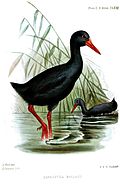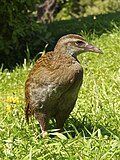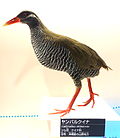| Image | Common name | Scientific name | Distribution |
|---|
 | Calayan rail | Gallirallus calayanensis
(formerly in Aptenorallus) | Calayan Island (far northern Philippines) |
 | Invisible rail | Gallirallus wallacii
(formerly in Habroptila) | Halmahera (northern Moluccas) |
 | Chestnut rail | Gallirallus castaneoventris
(formerly in Eulabeornis) | Aru Islands (southwest of New Guinea) and coastal north Australia |
 | Weka | Gallirallus australis | North Island, South Island, Stewart Island and satellites (New Zealand) |
 | †New Caledonian rail | Gallirallus lafresnayanus
(formerly in Cabalus) | forest of New Caledonia (probably extinct; no definite records since 1890) |
 | Lord Howe woodhen | Gallirallus sylvestris
(formerly in Hypotaenidia) | Lord Howe Island (east of Australia) |
 | Okinawa rail | Gallirallus okinawae
(formerly in Hypotaenidia) | forest and edge from lowlands to hills of northern Okinawa (Ryukyu Islands, southern Japan) |
 | †Tahiti rail | Gallirallus pacificus
(formerly in Hypotaenidia) | formerly Tahiti and adjacent eastern Society Islands; extinct, last reported 1800 |
 | Buff-banded rail | Gallirallus philippensis
(formerly in Hypotaenidia) | Philippines to Australia and Pacific islands |
 | †Chatham rail | Gallirallus modestus
(formerly in Cabalus) | formerly Chatham Islands; extinct, last reported 1900 |
 | †Dieffenbach's rail | Gallirallus dieffenbachii
(formerly in Hypotaenidia) | formerly Chatham Islands; extinct, last reported 1900 |
 | Pink-legged rail | Gallirallus insignis
(formerly in Hypotaenidia) | forest of New Britain (southeastern Bismarck Archipelago) |
 | Woodford's rail | Gallirallus woodfordi
(formerly in Hypotaenidia) | Solomon Islands |
 | †Bar-winged rail | Gallirallus poecilopterus
(formerly in Eulabeornis) | formerly Viti Levu and Ovalau, Fiji (western Polynesia); extinct, last reported 1973 |
 | Guam rail | Gallirallus owstoni
(formerly in Hypotaenidia) | forest of Guam (southern Mariana Islands); extinct in the wild until successfully reintroduced into Rota (southernmost Northern Mariana Islands) and Cocos Islands (just south of Guam) |
 | †Wake Island rail | Gallirallus wakensis
(formerly in Hypotaenidia) | formerly Wake Island; extinct, last reported 1944 |
 | Barred rail | Gallirallus torquatus
(formerly in Hypotaenidia) | Philippines, islets off Sabah (Malaysia), Sulawesi and satellites and west New Guinea |
| Roviana rail | Gallirallus rovianae
(formerly in Hypotaenidia) | New Georgia islands (west-central Solomon Islands) |
|


















